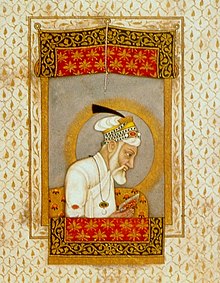ઔરંગઝેબ
છઠ્ઠો મુગલ સમ્રાટ
ઔરંગઝેબ (૧૬૧૮-૧૭૦૭) ભારતનો એક મુઘલ શાસક હતો. તે આખરી શક્તિશાળી મુઘલ શાસક હતો. તેના શાસનનો અધિકાંશ સમય દક્ષિણ તથા અન્ય સ્થાનો પર વિદ્રોહને કચડવાના કાર્યમાં વીત્યો હતો.
ઔરંગઝેબ | |
|---|---|
 | |
| જન્મ | ૩ નવેમ્બર ૧૬૧૮ દાહોદ |
| મૃત્યુ | ૩ માર્ચ ૧૭૦૭ અહમદનગર |
| અંતિમ સ્થાન | Tomb of Aurangzeb |
| બાળકો | Mehr-un-Nissa |
| પદની વિગત | Mughal emperor (૧૬૫૮–૧૭૦૭) |

ઔરંગઝેબનું જીવન વિવાદાસ્પદ રહ્યું હતું, જેમાં જજિયા વેરો, શરિયત (ઇસ્લામી કાનૂન) નિતીઓ, હિંદુ મંદિરોનો વિનાશ, તેના ભાઇ દારા સિકોહ, મરાઠા રાજા સાંભાજી[૧][૨] અને શિખોના નવમા ગુરુ તેગ બહાદુરની હત્યાઓનો સમાવેશ થાય છે.[૩][૪] ઇસ્લામી કાનૂન અનુસાર તેણે સંગીત, જુગાર, વ્યભિચાર, દારૂ અને નશીલા પદાર્થોના સેવન પર પ્રતિબંધ મૂક્યો હતો.[૫][૬] વિવિધ ઇતિહાસકારોના મત અનુસાર, તેની મંદિર તોડવાની પ્રવૃત્તિઓની સાથે[૭] તેણે મંદિરોનું બાંધકામ,[૮] અને સમારકામ[૯] પણ કરાવ્યું હતું.[૧૦]
સંદર્ભ ફેરફાર કરો
- ↑ J. L. Mehta (1 January 2005). Advanced Study in the History of Modern India: Volume One: 1707 – 1813. Sterling Publishers Pvt. Ltd. પૃષ્ઠ 47. ISBN 978-1-932705-54-6. મેળવેલ 7 April 2016.
- ↑ S. B. Bhattacherje (1 May 2009). Encyclopaedia of Indian Events & Dates. Sterling Publishers Pvt. Ltd. પૃષ્ઠ A80–A81. ISBN 978-81-207-4074-7. મેળવેલ 6 March 2012.
- ↑ Ayalon, David (1986). Studies in Islamic History and Civilisation. Brill. પૃષ્ઠ 271. ISBN 978-965-264-014-7.
- ↑ Abraham Eraly (2000), Emperors of the Peacock Throne: The Saga of the Great Mughals, Penguin Books, ISBN 978-0141001432, pages 398–399. According to Abraham Eraly, "in 1670, all temples around Ujjain were destroyed" and later "300 temples were destroyed in and around Chitor, Udaipur and Jaipur" among other Hindu temples destroyed elsewhere in campaigns through 1705.
Avari writes, "Aurangzeb's religious policy caused friction between him and the ninth Sikh guru, Tegh Bahadur. In both Punjab and Kashmir the Sikh leader was roused to action by Aurangzeb's excessively zealous Islamic policies. Seized and taken to Delhi, he was called upon by Aurangzeb to embrace Islam and, on refusal, was tortured for five days and then beheaded in November 1675. Two of the ten Sikh gurus thus died as martyrs at the hands of the Mughals. (Avari (2013), page 115) - ↑ Haroon, Asif (2004). Muhammad Bin Qasim to General Pervez Musharraf: Triumphs, Tribulations. Lahore: Sang-e-Meel. પૃષ્ઠ 70. ISBN 978-969-35-1624-1.
To start with, Aurangzeb gradually transformed the system of governance as per the dictates of Shariah ... He curbed evil practices of gambling, drinking and prostitution
- ↑ "Mughal dynasty | History, Map, & Facts". Encyclopædia Britannica. મેળવેલ 2018-10-06.
- ↑ Avari 2013, p. 115: citing a 2000 study, writes "Aurangzeb was perhaps no more culpable than most of the sultans before him; they desecrated the temples associated with Hindu power, not all temples. It is worth noting that, in contrast to the traditional claim of hundreds of Hindu temples having been destroyed by Aurangzeb, a recent study suggests a modest figure of just fifteen destructions."
- ↑ Ian Copland; Ian Mabbett; Asim Roy; Kate Brittlebank; Adam Bowles (2013). A History of State and Religion in India. Routledge. પૃષ્ઠ 119. ISBN 978-1-136-45950-4.
- ↑ B. N. Pande (1996). Aurangzeb and Tipu Sultan: Evaluation of Their Religious Policies. University of Michigan. ISBN 9788185220383.
- ↑ "Aurangzeb gave temples grants, land: Historian". Economic Times. 13 September 2015. મેળવેલ 03 March 2020. Check date values in:
|access-date=(મદદ)
| આ ભારતીય ઇતિહાસ સંબંધિત લેખ છે. તમે તેને વિસ્તૃત કરીને વિકિપીડિયાને મદદ કરી શકો છો. |